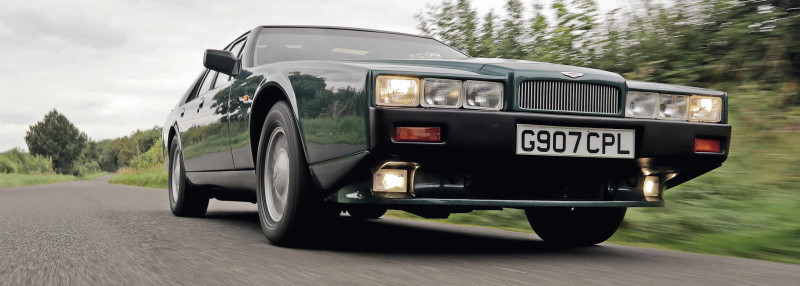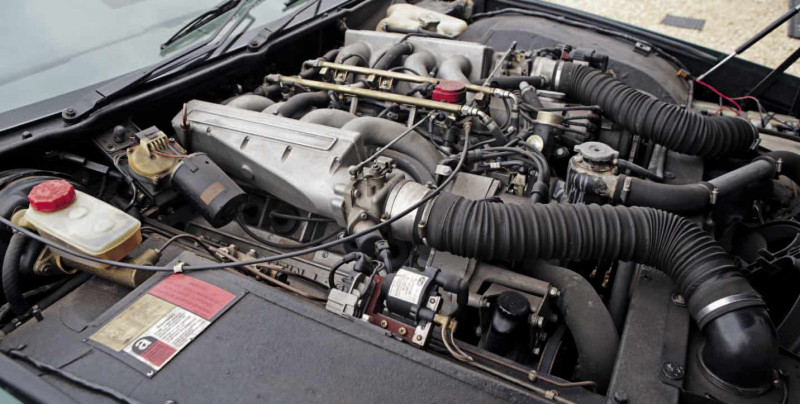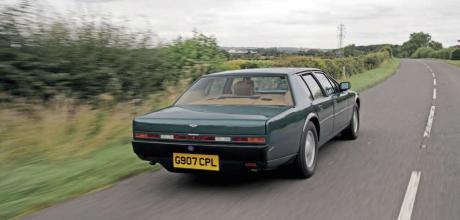1990 Aston Martin Lagonda Series 4 Saloon
The Aston Martin Lagonda pushed the boundaries of what was possible and permissible with a saloon car. It hasn’t lost the power to shock. Words: Richard Heseltine Picrures: Richard Dredge and Vicky Kitchen.
DRIVING ASTON’S OUTRAGEOUS TECHNO-BARGE 1990 Aston Martin Lagonda Series 4 Saloon
SHOCK AND AWE “Short of being accompanied by a marching band, there is little you can do to appear more conspicuous.”
The looks of incredulity are writ large. Turning around in the entrance to a farmyard for the third time in as many minutes, we’re starting to attract attention. Our hero mouths shapes, his friend grabbing his arm and squeezing the point home. They must be all of eight years old, looks of unfeigned wonder morphing into toothy smiles. Before long, they’re accompanied by adults, and normally at this juncture on a photo shoot you get ‘asked’ to move along, but no. Please, by all means, continue to perform a 578-point turn in your strange car. We’ll just watch and shout a few observations.

In no way is the ‘wedge’ Lagonda a car for the shy and retiring. Short of being accompanied by a marching band, there is little you can do to appear more conspicuous. Driving one is an event. This super-saloon remains an attention-getter like no other, that’s for sure, even if this is notionally the, cough, ‘toned-down’ version. It is magnificent in a manner that almost makes it indemnified against criticism. You can knock it all day long, and in some instances with good reason, but just look at it. What a thing!
“The flaws here really do accentuate the positives. It’s a joyous, stupid, brilliant, exasperating, compelling and rewarding slice of otherworldliness.”
Few saloon cars, if any, approach its air of sainted lunacy. It exists in its own little bubble, and always has. The thing is, what amazes more than anything is that the Lagonda was built at all. It was a daring design, to put it mildly, if only in terms of the visuals. It’s easy to take risks if you have a safety net, but scroll back to the mid-1970s and parent marque Aston Martin was haemorrhaging, Midlands-based owner Company Developments struggling to cauterise wounds inflicted by a fuel crisis, industrial unrest, the imposition of VAT, the three-day working week, and more besides.

Into the breach stepped an American-Canadian consortium, and with it fresh hope for the future. That, and a new name, Aston Martin (1975) Ltd. The new regime would create a raft of fresh models, and these included a four-door range-topper. It fell to designer William Towns and chief engineer Mike Loasby to usher in this brave new world, the former producing preliminary sketches in February 1976, working 12-hour days for a month while he readied his proposal. The former Rootes Group and Rover man produced a radical three-box outline unlike anything then on sale.

Loasby didn’t exactly hold back, either. For starters, he proposed using advanced electronic instrumentation with graphic and digital solid-state displays. These would be developed in conjunction with the Cranfield Institute of Technology. Loasby had become captivated by touch-sensitive switches during a visit to the National Semiconductor HQ in California (they were employed in the lifts…). The Lagonda would feature such techno-sorcery to operate everything from the pop-up headlights to the automatic transmission. Pragmatism came into play, too, with Loasby borrowing the long-wheelbase platform from the ill-starred V8 Lagonda Series 1 (essentially a saloon variant of the familiar Aston fastback) to which a steel sub-structure was attached which anchored the aluminium body panels. The proven quadcam 5.3-litre V8 was also carried over and allied to a three-speed Chrysler Torque Flite automatic transmission. The V8 Aston coupé gave up its steering, brakes and suspension, with unequal-length wishbones and an anti-roll bar up front, plus a de Dion rear axle located by parallel arms and a transverse Watt linkage. Self-levelling dampers were employed at each corner.

Incredibly, the prototype was unveiled at a media event at The Bell Inn in Aston Clinton on 12 October 1976, just seven and a bit months after the initial renderings were produced. A few days later, the car was unveiled to a shellshocked public at the British International Motor Show at Earls Court. It was caused a furore, with even the oft-fusty Road & Track labelling it ‘the undisputed star of the show,’ before stating: ‘Try to blast Aston Martin for being too conservative after this one! To say the least, the Lagonda is different… Typically, one oil-rich Arab has already ordered a fleet of six.’
It was an extraordinary performance for a company that had been in the hands of the receiver a year earlier. By the end of the show, more than 150 deposits at £2000 apiece had been taken, which represented 10% of the intended end price. Inevitably, some naysayers doubted the veracity of claims that production would start any time soon, and they were proved right. Problems with perfecting the Lagonda (dubbed Series 2 in marque speak), not least its complicated instrumentation arrangement, caused endless delays.
In April 1978, the first car was delivered to Lord Tavistock at Woburn Abbey. The handover ceremony before the media didn’t go quite as planned, though: electrical gremlins rendered the car immobile, his Lordship’s wedding anniversary present being pushed the final distance before Lady Tavistock received it. Only 16 cars were made during the first two years of production, the Cranfield electrical system making way for one developed by Dallas-based Refoy along the way. Digital instrumentation superseded the previous gas-plasma display, the electronic gearchange being replaced by a conventional automatic selector.
Despite the difficult gestation, the Lagonda soon found its feet, with the majority of customers being found in the USA and the Middle East, the price tag having almost doubled from the launch price to just shy of £50,000. It was a genuine performance weapon, too, with Autocar recording a top speed of 148mph in October 1980. That year also saw the factory toy with the idea of offering a twin-turbo variant.
One car was built which purportedly pumped out 380bhp, but it remained unique amid further turmoil. A year later, Victor Gauntlett stepped in and gradually righted the ship. 1983 saw a raft of detail revisions, not least the adoption of larger bumpers, BBS alloy wheels and opening rather than fixed rear windows. A year later, cathode-ray instrumentation was added, incorporated into three small TV-like screens and allied to a synthesised warning system. In January 1985, the Series 3 variant was introduced, which gained fuel-injection, and Vacuum uorescent (VF) instrumentation along the way. It was near identical to the outgoing model visually, but the same cannot be said of the Series 4, as here, that was revealed at the Geneva motor show in March 1987.
Towns was hired to give the car a makeover, the ‘origami’ look that had been the hot ticket during the 1970s having become decidedly passé in the ’80s (the remodel coincided with the need to replace existing tooling). While the glass remained the same, the body panels were new. The sharp edges were softened, the pop-up headlights replaced by a sextet of fixed units. The swage-line was also deleted, while fuel fillers were relocated from the C-pillars to the base of the rear screen. Sill skirts and front and rear undertray were added, while the wheels were enlarged from 15- to 16-inch items shod with low-profile Avon Turbospeed rubber.
According to some sources, Towns was displeased with the end result, opining that his brief hadn’t been followed to the letter by the draughtsmen in Newport Pagnell. Whatever the truth, the Series 4 rounded out production to the end in January 1990. Just 643 cars were made of all kinds, the run-out edition accounting for 105 of those. The example pictured here was made in 1990 and is perhaps the best-known of all Series 4 Lagondas, having once formed part of the Hunter Green Collection that comprised nine Aston models with the same exterior hue and tan leather upholstery. The assemblage was broken up in 2005, and ‘our’ car currently resides in the JHW Classics collection with fewer than 5000 miles on the clock. As such, it is like new.
What you tend to forget is that this was a long car by period standards; some 5283mm from stem to stern, although conversely more slender and lower than its Aston coupé stablemate (its 1321mm height is the same as a late-1980s Porsche 911). The Series 4 makeover may have removed some of the original model’s architectural wondrousness, but it isn’t exactly conventional. For starters, it has the longest front overhang in Christendom, the spoiler appearing almost an afterthought (it’s akin to a double chin according to one onlooker). It just looks so… strange.
Step aboard and the cabin represents a mixture of the mad and the maddening. Despite appearances to the contrary, it isn’t really a saloon car. By that, we mean it’s best to think of it as a 2+2 with four doors because there is little rear leg room. Up front, the transmission tunnel intrudes somewhat, being set far back in the chassis, while the pedals are offset but you soon acclimatise. You have little choice. The instrument binnacle, for want of a better description, is huge and fronted by a vaguely Citroën-esque wheel, the telling part being the bank of push-buttons.
Without wishing to incur the wrath of marque types, this is no bad thing because the touch-sensitive kind weren’t always user-friendly. Some of the push buttons here do bear a stark likeness to those found in 1980s Austin-Rover products, mind, but then parts bin thievery is often the preserve of automotive aristocracy. They don’t look out of place and are, whisper it, comprehensible. In marked contrast to the instrument binnacle, the centre console with its timber veneer and corporate winged logo looks strangely out of keeping; conservative even. If period stats are to be believed, the Lagonda packs 309bhp at 5500rpm and 320lb ft of the good stuff at 4000rpm. It is a bit on the hefty side, though, tipping the scales at 2062.5kg. As such, initial acceleration isn’t electrifying, the factory quoting a 0-60mph time of 8.4 seconds. On the ipside, the enduring V8 produces a lovely, throaty rumble under load and is smooth throughout the rev range.
And it is worth piling on the revs, even if there is no real need to do so such is the torque spread, just to see the parabolic bar graph do its little dance. While perhaps not super-quick, the way in which the Lagonda builds momentum impresses. Under load, it doesn’t feel as though it is in danger of running out of puff. Fast Lane mustered a top speed of 145.3mph, which seems eminently believable, changes on the auto ’box being well-cushioned. From a standing start, it shifts up at roughly 50 and 80mph, and, well, we chickened out shortly thereafter. Kickdown also works extremely well by contemporary standards, too. It sounds choral under load; more refined and blue-blooded than a Detroit bent eight but snarly with it.
Treated as a cruiser, the ride quality is way better than you might expect. It deals with rutted and uneven surfaces well. There appears to be plenty of suspension travel, too. The part of the car’s repertoire that never ceases to amaze is just how well it handles. You don’t approach the Lagonda expecting to assault backroads, but it’s up to the task. The variable-assistance rack-and-pinion steering offers way more feel than most latter-day set-ups, even if it is strangely heavy at low speeds (and the lock is abysmal). The Lagonda belies its relative bulk in the corners, the chassis proving wonderfully communicative in a way that most regular Astons from the 1970s and ’80s are not. Without pushing the car particularly hard, it is nevertheless clear than the Lagonda’s nose will go first.
Several road tests from way back suggested that even then it would understeer mildly and progressively without undue drama. The limited-slip differential ensured that traction isn’t a problem in most conditions, and you cannot imagine flinging this car around on opposite lock. Firstly, you would have to really provoke it, and why would you? Secondly, a ailing tail would probably take out a small cottage before you had gathered it all up again. The brakes – big, ventilated discs, the rears mounted inboard – scrub off speed well, even if you do need to press the pedal pretty hard.
If anything, pre-facelift cars are even more agile, but the beauty of the Series 4 is that it works. It is awed in so many ways, and on so many levels, but captivating and convincing with it. The Lagonda doesn’t work brilliantly as a saloon car, but defies preconceptions (and gravity) as a Gran Turismo. There is so much to love here so long as you accept its many foibles; perhaps even embrace them. The flaws here really do accentuate the positives. It’s a joyous, stupid, brilliant, exasperating, compelling and rewarding slice of otherworldliness.
And it isn’t as though anyone ever bought a wedge Lagonda by accident. When new, this car cost an eye-watering £87,500. That’s around £205,000 adjusted for inflation.
You had to really want one because many quantifiably better luxury cars were available for a lot less. Here was a machine that you fully bought into or not at all. Nothing has changed in the meantime. We haven’t touched on current prices, running costs, or so on. This isn’t a buying guide. Think of it more as an appreciation of a car that makes no sense at all, but one that equally makes all the sense in the world.
Thank you to Jane Weitzmann of jhwclassics.com.


